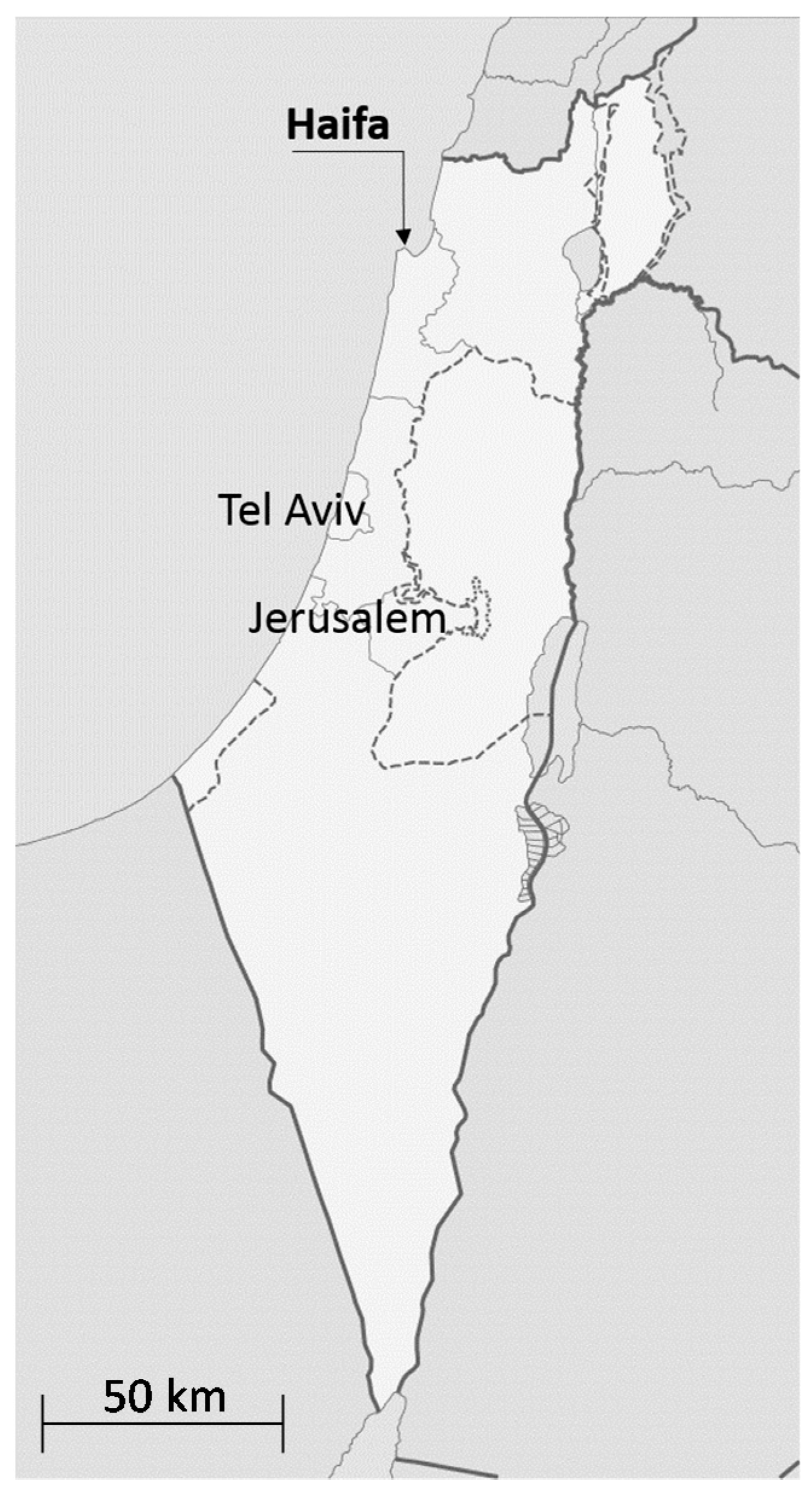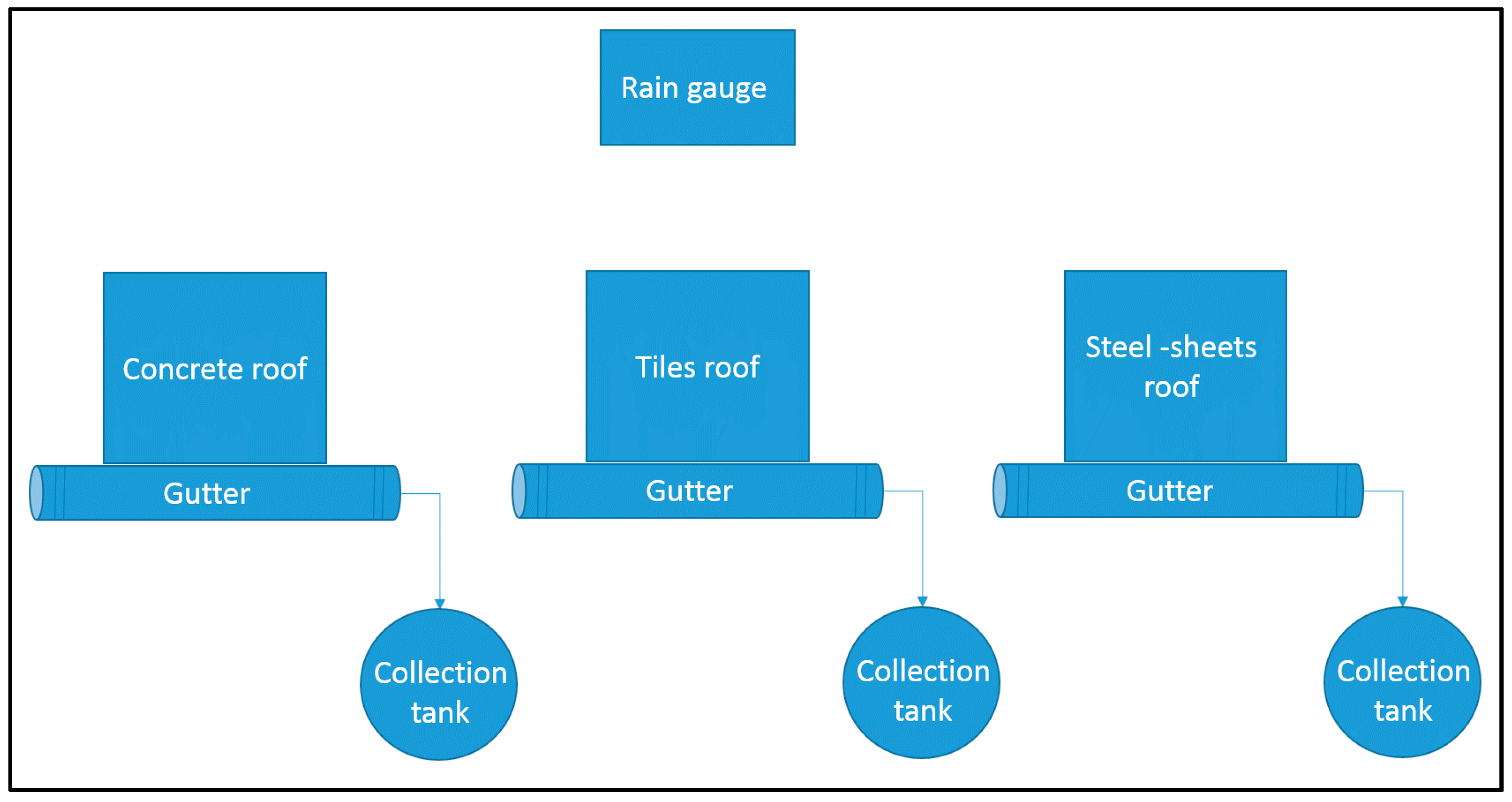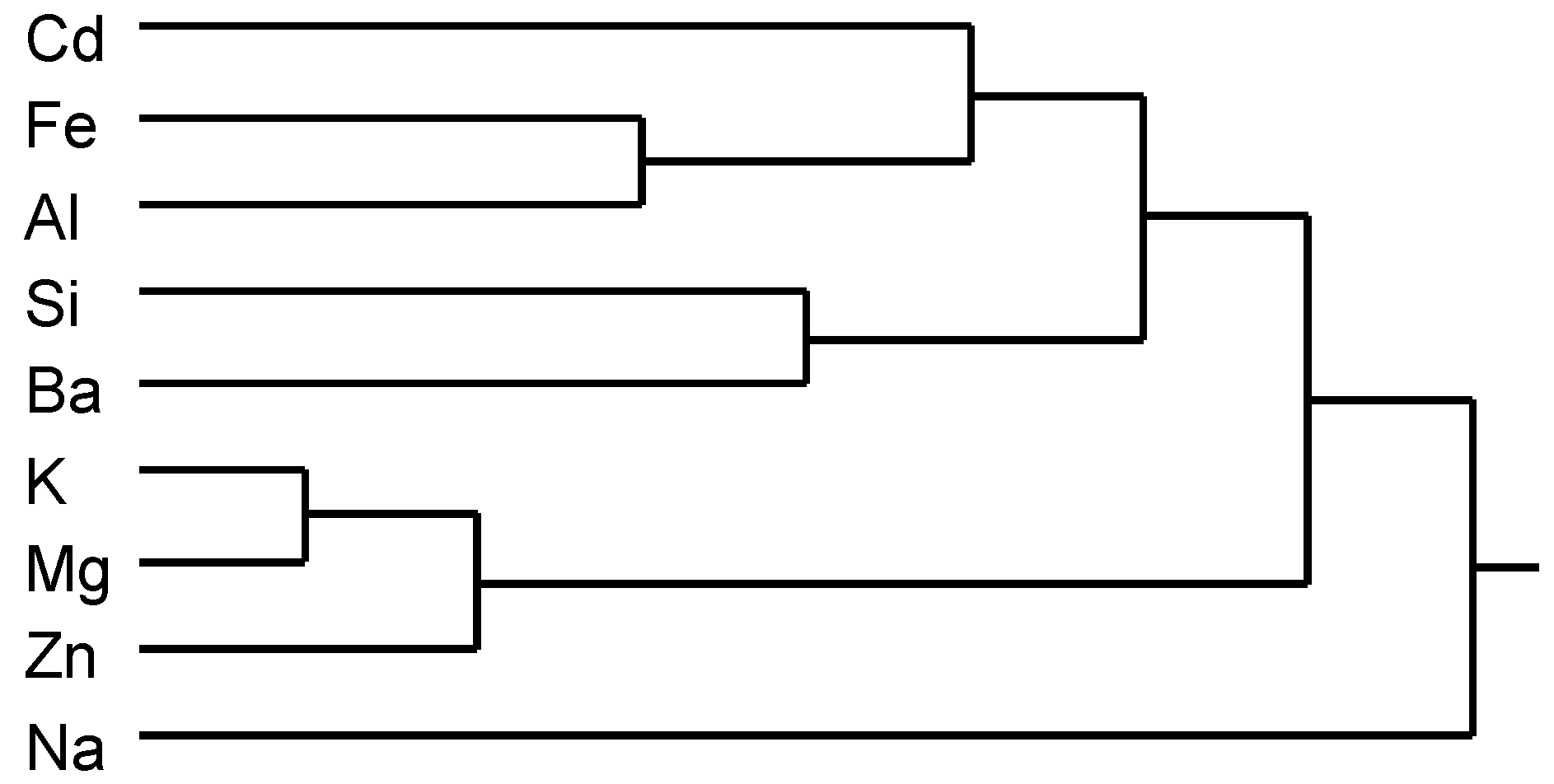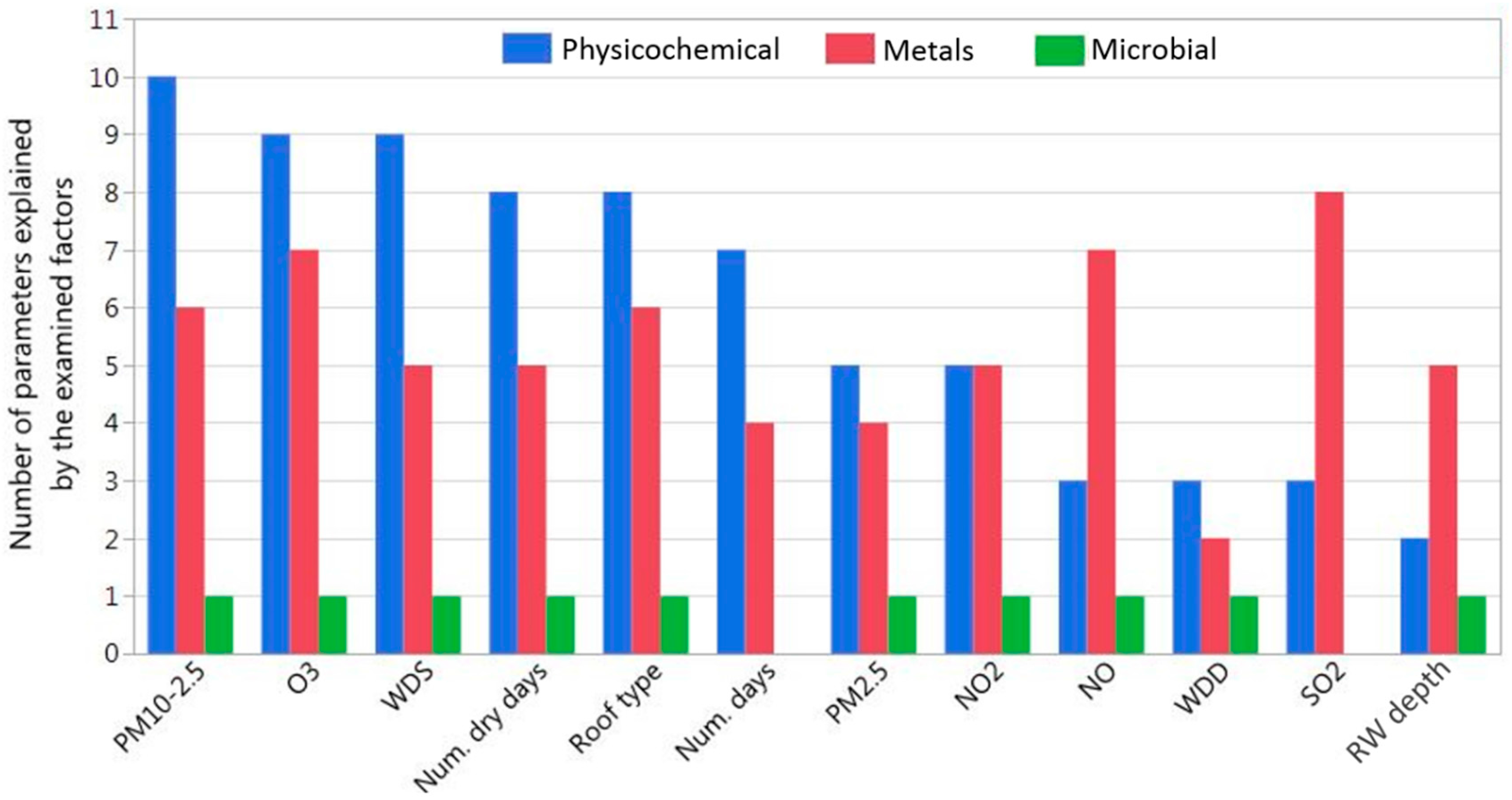Quality of Roof-Harvested Rainwater as a Function of Environmental and Air Pollution Factors in a Coastal Mediterranean City (Haifa, Israel)
Abstract
:1. Introduction
2. Materials and Methods
2.1. Study Site
2.2. Analysis Methods
2.2.1. Physicochemical Parameters
2.2.2. Microbial Quality
2.2.3. Heavy Metals
2.2.4. Air Quality
2.3. Data Analysis
3. Results and Discussion
3.1. Roof Runoff Quality
3.2. Factors Affecting Roof Harvested Rainwater Quality
3.2.1. Physicochemical Parameters
3.2.2. Microbial Quality
3.2.3. Metals
3.3. Overall Effects of the Explanatory Factors
4. Summary and Conclusions
Author Contributions
Conflicts of Interest
References
- Aladenola, O.O.; Adeboye, O.B. Assessing the potential for rainwater harvesting. Water Resour. Manag. 2010, 24, 2129–2137. [Google Scholar] [CrossRef]
- Jones, M.P.; Hunt, F.W. Performance of rainwater harvesting systems in the southeastern United States. Resour. Conserv. Recycl. 2010, 54, 623–629. [Google Scholar] [CrossRef]
- Campisano, A.; Butler, D.; Ward, S.; Burns, M.J.; Friedler, E.; DeBusk, K.; Fisher-Jeffes, L.N.; Ghisi, E.; Rahman, A.; Furumai, H.; et al. Urban rainwater harvesting systems: Research, implementation and future perspectives. Water Res. 2017, 115, 195–209. [Google Scholar] [CrossRef] [PubMed]
- Meera, V.; Ahammed, M.M. Water quality of rooftop rainwater harvesting systems: A review. J. Water Supply Res. Technol. AQUA 2006, 55, 257–268. [Google Scholar]
- Forster, J. The influence of location and season on the concentrations of macro-ions and organic trace pollutants in roof runoff. Water Sci. Technol. 1998, 38, 83–90. [Google Scholar]
- Taffere, G.R.; Beyene, A.; Vuai, S.A.; Gasana, J.; Seleshi, Y. Characterization of atmospheric bulk deposition: Implications on the quality of rainwater harvesting Systems in the Semi-Arid City of Mekelle, northern Ethiopia. Environ. Process. 2016, 3, 247–261. [Google Scholar] [CrossRef]
- Neibaur, E.E.; Anderson, E.P. An examination of factors affecting sustainability of domestic rainwater harvesting systems in a rural, semi-arid region of Mexico. Water Sci. Technol. Water Supply 2016, 16, 1388–1397. [Google Scholar] [CrossRef]
- Forster, J. Patterns of roof runoff contamination and their potential implications on practice and regulations of treatment and local infiltration. Water Sci. Technol. 1996, 33, 39–48. [Google Scholar]
- Chang, M.; McBroom, M.W.; Beasley, R.S. Roofing as a source of nonpoint water pollution. J. Environ. Manag. 2004, 73, 307–315. [Google Scholar] [CrossRef] [PubMed]
- Magyar, M.I.; Ladson, A.R.; Diaper, C.; Mithchell, V.G. Influence of roofing materials and lead flashing on rainwater tank contamination by metals. Aust. J. Water Resour. 2014, 18, 71–84. [Google Scholar] [CrossRef]
- Uba, B.N.; Aghogho, O. Rainwater quality from different roof catchments in the Port Harcourt District, Rivers State, Nigeria. J. Water Supply Res. Technol. AQUA 2000, 49, 281–288. [Google Scholar]
- Evans, C.A.; Coombes, P.J.; Dunstan, R.H. Wind, rain and bacteria: The effect of weather on the microbial composition of roof-harvested rainwater. Water Res. 2006, 40, 37–44. [Google Scholar] [CrossRef] [PubMed]
- Ahmed, W.; Gardner, T.; Toze, S. Microbiological quality of roof-harvested rainwater and health risks: A review. J. Environ. Qual. 2011, 40, 13–21. [Google Scholar] [CrossRef] [PubMed]
- Lye, J.D. Rooftop runoff as a source of contamination: A review. Sci. Total Environ. 2009, 407, 5429–5434. [Google Scholar] [CrossRef] [PubMed]
- Despins, C.; Farahbakhsh, K.; Leidl, C. Assessment of rainwater quality from rainwater harvesting systems in Ontario, Canada. J. Water Supply Res. Technol. AQUA 2009, 58, 117–134. [Google Scholar] [CrossRef]
- Farreny, R.; Morales-Pinzon, T.; Guisasola, A.; Taya, C.; Rieradevall, J.; Gabarrell, X. Roof selection for rainwater harvesting: Quantity and quality assessments in Spain. Water Res. 2011, 45, 3245–3254. [Google Scholar] [CrossRef] [PubMed]
- Muklada, H.; Gilboa, Y.; Friedler, E. Stochastic modelling of the hydraulic performance of an onsite rainwater harvesting system in Mediterranean climate. Water Sci. Technol. Water Supply 2016, 16, 1614–1623. [Google Scholar] [CrossRef]
- American Public Health Association; American Water Works Association; Water Environment Federation. Standard Methods for the Examination of Water and Wastewater; APHA: Washington, DC, USA; AWWA: Denver, CO, USA; WEF: Alexandria, VA, USA, 2005. [Google Scholar]
- Ramlall, C.; Varghese, B.; Ramdhani, S.; Pammenter, N.W.; Bhatt, A.; Berjak, P. Effects of simulated acid rain on germination, seedling growth and oxidative metabolism of recalcitrant-seeded Trichilia dregeana grown in its natural seed bank. Physiol. Plant. 2015, 153, 149–160. [Google Scholar] [CrossRef] [PubMed]
- Mamane, Y.; Gottlieb, J. Ten years of precipitation chemistry in Haifa, Israel. Water Air Soil Pollut. 1995, 82, 549–558. [Google Scholar] [CrossRef]
- Kieber, R.J.; Long, M.S.; Willey, J.D. Factors influencing nitrogen speciation in coastal rainwater. J. Atmos. Chem. 2005, 52, 81–99. [Google Scholar] [CrossRef]
- Israel Ministry of Health. Potable Water Quality Regulations; IMH: Jerusalem, Israel, 2012; p. 35. (In Hebrew) [Google Scholar]
- Hueglin, C.; Gehrig, R.; Baltensperger, U.; Gysel, M.; Monn, C.; Vonmont, H. Chemical characterisation of PM2.5, PM10 and coarse particles at urban, near-city and rural sites in Switzerland. Atmos. Environ. 2005, 39, 637–651. [Google Scholar] [CrossRef]
- Yaziz, M.I.; Gunting, H.; Sapari, N.; Ghazali, A.W. Variations in rainwater quality from roof catchments. Water Res. 1989, 23, 761–765. [Google Scholar] [CrossRef]
- Sanchez, A.S.; Cohim, E.; Kalid, R.A. A review on physicochemical and microbiological contamination of roof-harvested rainwater in urban areas. Sustain. Water Qual. Ecol. 2015, 6, 119–137. [Google Scholar] [CrossRef]




| Potential Explanatory Factors | Units | |
|---|---|---|
| Environmental factors | Rain depth (RD) | mm/event |
| Number of days from the beginning of the rainy season 1 (DN) | days | |
| Length of dry period between consecutive rain events (ADP) | days | |
| Roof type: concrete, tile and isolated steel sheets (RT) | - | |
| Air pollution factors 2 | PM2.5 | µg/m3 |
| PM2.5–10 | µg/m3 | |
| SO2 | ppb | |
| NO | ppb | |
| NO2 | ppb | |
| O3 | ppb | |
| WDD 3 | deg | |
| WDS | m/s |
| Parameter | Units | Avg. | Std | Median | Range | 25% | 75% | N | IPWQR |
|---|---|---|---|---|---|---|---|---|---|
| Rainwater depth | mm/event | 15.1 | 14.9 | 9.9 | 57–0.2 | 3.9 | 20.9 | 158 | NR |
| Antecedent dry weather period | d | 4.97 | 7.52 | 1.0 | 0–40 | 0 | 6.75 | 156 | NR |
| Turbidity | NTU | 26.0 | 32.6 | 12.7 | 143–0.7 | 5.83 | 30.5 | 147 | 1.0 |
| EC | µS/cm | 91.1 | 85.3 | 77.1 | 660–0.19 | 51.04 | 106.1 | 147 | |
| pH | mg/L | 7.01 | 0.78 | 6.9 | 10.7–5.5 | 6.58 | 7.19 | 149 | 6.5–9.5 |
| TSS | mg/L | 29.2 | 47.0 | 13.4 | 279–0 | 2.9 | 33.4 | 153 | |
| VSS | mg/L | 20.0 | 39.2 | 5.4 | 244–0 | 0 | 20.4 | 153 | |
| TOC | mg/L | 4.75 | 3.14 | 4.19 | 14.4–0.7 | 2.28 | 6.89 | 130 | |
| COD | mg/L | 20.1 | 43.3 | BDL | BDL-204 | BDL | 16.4 | 109 | |
| OD254 | 1/cm | 0.01 | 0.01 | 0.006 | 0.06–0 | 0.002 | 0.014 | 151 | |
| TN | mg/L | 1.25 | 1.05 | 0.96 | 5.34–0.173 | 0.76 | 1.16 | 101 | 15.8 1 |
| Alkalinity | mg/L 2 | 75.2 | 87.7 | 48.0 | 0.21–428 | 18.46 | 91.9 | 114 | |
| Hardness | mg/L 2 | 28.1 | 17.1 | 24.9 | 98.7–3.7 | 14.7 | 36.18 | 128 | |
| FC | cfu/100 mL | 4.90 | 9.36 | 1.0 | BDL-44.0 | BDL | 4 | 51 | BDL(TC) 3 |
| Al | mg/L | 0.021 | 0.02 | 0.015 | 0.13–0.002 | 0.009 | 0.026 | 131 | 0.2 |
| Ba | mg/L | 0.03 | 0.05 | 0.014 | 0.36–0.002 | 0.008 | 0.037 | 128 | 1.0 |
| Ca | mg/L | 9.80 | 8.06 | 7.9 | 55.9–1.014 | 4.3 | 12.6 | 130 | |
| Cd | mg/L | 0.018 | 0.024 | 0.012 | 00.0026–0.14 | 0.007 | 0.018 | 130 | 0.005 |
| Fe | mg/L | 0.014 | 0.01 | 0.013 | 0.002–0.07 | 0.007 | 0.02 | 131 | 1.0 |
| K | mg/L | 1.42 | 2.15 | 0.76 | 15.2–0.07 | 0.4 | 1.4 | 117 | |
| Mg | mg/L | 1.40 | 1.25 | 1.12 | 9.94–0.205 | 0.74 | 1.57 | 130 | |
| Na | mg/L | 6.53 | 5.79 | 4.5 | 29.3–1.33 | 2.8 | 7.5 | 122 | |
| Si | mg/L | 0.96 | 1.23 | 0.29 | 6.04–0.002 | 0.14 | 1.62 | 132 | |
| Sr | mg/L | 0.044 | 0.05 | 0.031 | 0.28–0.006 | 0.02 | 0.044 | 44 | |
| Zn | mg/L | 0.17 | 0.203 | 0.12 | 1.29–0.001 | 0.03 | 0.22 | 130 | 5.0 |
| Parameter | Intercept | RD | DN | ADP | Roof Type ** | PM2.5 * (µg/m3) | PM2.5–10 * (µg/m3) | O3 * (ppb) | SO2 * (ppb) | NO * (ppb) | NO2 * (ppb) | WDD * (deg.) | WDS * (m/s) | NEV | R2 |
|---|---|---|---|---|---|---|---|---|---|---|---|---|---|---|---|
| FC | 76.5 | −0.47 | −1.52 | −1.31 t | −0.45 | 0.49 | 1.13 | 7.58 | −1.83 | −0.29 | −7.83 | 10 | 0.87 | ||
| Sr | 0.397 | −0.002 | −0.001 | −0.005 | 0.003 | 0.003 | 0.144 | 0.066 | −0.009 | 0.0023 | −0.002 | 10 | 0.86 | ||
| Si | 0.4599 | −0.009 | 0.0112 | −1.108 s | −0.0105 | 0.0092 | 0.0186 | 0.2195 | 0.0387 | 8 | 0.78 | ||||
| Alkalinity | −248 | −0.69 | −5.55 | −28.9 s | 5.18 | −2.65 | 12.2 | −18.4 | 6.02 | 0.32 | −24.8 | 10 | 0.70 | ||
| TN | −0.025 | −0.009 | −0.01 | −0.036 | −0.22 c | 0.099 | −0.056 | 0.103 | −0.15 | 8 | 0.63 | ||||
| TOC | 16.6 | 0.248 | −0.57 c | −0.095 | 0.07 | −0.16 | 1.23 | −0.55 | −0.009 | −0.48 | 9 | 0.49 | |||
| OD254 | 0.017 | 1.0e-4 | 3.0e-4 | −0.002 c | 0.00025 | 0.0020 | −5.0e-4 | −3.53e-5 | −1.5e-3 | 8 | 0.47 | ||||
| Na | −0.848 | −0.076 | 0.0532 | 0.065 | 0.2441 | 3.012 | −2.471 | 0.1123 | 0.145 | 0.123 | 9 | 0.47 | |||
| Zn | 0.123 | 0.0068 | 0.164 s | 0.039 | −0.0194 | −0.0067 | 5 | 0.47 | |||||||
| EC | −130 | −0.55 | −6.9 s | 0.70 | −0.60 | 2.8 | 4.4 | 8.6 | 7 | 0.44 | |||||
| Ca | 8.287 | −0.085 | 0.367 | −3.421 s | 0.089 | 4 | 0.44 | ||||||||
| Turb. | −19.6 | 0.21 | 0.71 | −0.32 | 0.83 | 4 | 0.43 | ||||||||
| Hardness | 9.54 | −7.07 | 17.7 | −8.66 s | 17.54 | 7.67 | 16.95 | −14.8 | 7 | 0.42 | |||||
| Al | 0.0035 | 0.0002 | 0.0004 | 0.0075 | −0.0008 | 0.0007 | 0.0043 | 0.0098 | −0.0009 | 8 | 0.42 | ||||
| COD | −129 | 1.87 | −7.49 c | −0.26 | 2.57 | −9.76 | 6.32 | 9.62 | 7 | 0.38 | |||||
| pH | 4.88 | 0.0034 | 0.486 c | 0.018 | 0.086 | 0.187 | 5 | 0.34 | |||||||
| Fe | 0.0011 | −0.0014 c | 0.0002 | 0.0012 | 0.0001 | 4 | 0.30 | ||||||||
| K | −1.08 | 0.4644 c | 0.0158 | 0.068 | 0.11 | −0.093 | −0.052 | 6 | 0.29 | ||||||
| Mg | −1.041 | 0.006 | 0.0117 | 0.0348 | 0.543 | −0.432 | 5 | 0.29 | |||||||
| Ba | 0.065 | −0.021 c | 1 | 0.28 | |||||||||||
| Cd | 0.0462 | 0.0002 | 0.0042 | −0.0026 | 3 | 0.28 | |||||||||
| TSS | −20.9 | 0.055 | 0.64 | 1.61 | −8.74 | 4 | 0.24 | ||||||||
| VSS | −3.48 | 0.52 | 0.82 | −5.48 | 3 | 0.20 |
© 2017 by the authors. Licensee MDPI, Basel, Switzerland. This article is an open access article distributed under the terms and conditions of the Creative Commons Attribution (CC BY) license (http://creativecommons.org/licenses/by/4.0/).
Share and Cite
Friedler, E.; Gilboa, Y.; Muklada, H. Quality of Roof-Harvested Rainwater as a Function of Environmental and Air Pollution Factors in a Coastal Mediterranean City (Haifa, Israel). Water 2017, 9, 896. https://doi.org/10.3390/w9110896
Friedler E, Gilboa Y, Muklada H. Quality of Roof-Harvested Rainwater as a Function of Environmental and Air Pollution Factors in a Coastal Mediterranean City (Haifa, Israel). Water. 2017; 9(11):896. https://doi.org/10.3390/w9110896
Chicago/Turabian StyleFriedler, Eran, Yael Gilboa, and Hussein Muklada. 2017. "Quality of Roof-Harvested Rainwater as a Function of Environmental and Air Pollution Factors in a Coastal Mediterranean City (Haifa, Israel)" Water 9, no. 11: 896. https://doi.org/10.3390/w9110896
APA StyleFriedler, E., Gilboa, Y., & Muklada, H. (2017). Quality of Roof-Harvested Rainwater as a Function of Environmental and Air Pollution Factors in a Coastal Mediterranean City (Haifa, Israel). Water, 9(11), 896. https://doi.org/10.3390/w9110896






